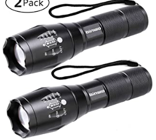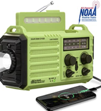Light & Electricity
Electrical power outages are one of the most common components of emergencies and disasters; almost all of the natural and human-made disasters can affect access to power. Electricity is also one of the most important supports for ‘normal’ life; it is essential for light, heating, cooling, communication, and many other functions such as home medical equipment and garage door openers.
Preparing for a power outage is one of the most critical and highest priority components of general preparedness. We will start with light sources.
Emergency and portable light sources
Essential – at least one flashlight per person, in your bedroom, located so that you can reach it from bed and so it won’t fall down and roll away in an earthquake (see section on Household Preparations).
Extremely Desirable – at least 2 flashlights per person (1 in bedroom, 1 in go-bag (see Go-bag section), plus 1 in the car. Even more if possible.
 HEADLAMP: Great for hands-free light. Many available $10 and up. Suggested Petzl Zipka (at right) is a bit pricey at ~$30, but the pull-out band makes it very compact, no adjustment needed for different heads, easy to use hand-held or attached to something other than your head. Multi-mode, 120 hours of light on low setting.
HEADLAMP: Great for hands-free light. Many available $10 and up. Suggested Petzl Zipka (at right) is a bit pricey at ~$30, but the pull-out band makes it very compact, no adjustment needed for different heads, easy to use hand-held or attached to something other than your head. Multi-mode, 120 hours of light on low setting.
BATTERY HINTS: Buy flashlights w/o batteries and put in good name brands – Duracell, Ray-O-Vac, Energizer. If a cheap flashlight doesn’t work you find out right away, if a cheap battery only lasts 30 minutes, it’s enough time to get in trouble.
 FLASHLIGHTS: (small but not mini): Many, many brands available in the $6-10 range (examples at right), and often available in packs of 2 to 6. Typically with 3 AAA cells, 5 modes, and sometimes an adjustable beam. CAUTION – the lanyards on these are typically not big enough to fit over your wrist and permit using 2 hands for something else. See the special note on Lanyards for information on making/using lanyards.
FLASHLIGHTS: (small but not mini): Many, many brands available in the $6-10 range (examples at right), and often available in packs of 2 to 6. Typically with 3 AAA cells, 5 modes, and sometimes an adjustable beam. CAUTION – the lanyards on these are typically not big enough to fit over your wrist and permit using 2 hands for something else. See the special note on Lanyards for information on making/using lanyards.
MORE BATTERY HINTS:Alkaline batteries are good, but can leak and aren’t real tolerant of extreme temperatures. Lithium batteries are more expensive, but are more robust and long lived. In extreme environments (like your car), or if you won’t change batteries every year or so, lithium batteries may be worth the extra $.
 EMERGENCY LIGHT: plugs into an outlet and goes on when power goes off; can be used as flashlight. Consider as soon as you have enough of the lights listed above — at least for the bedroom, preferably all main rooms.
EMERGENCY LIGHT: plugs into an outlet and goes on when power goes off; can be used as flashlight. Consider as soon as you have enough of the lights listed above — at least for the bedroom, preferably all main rooms.
Why is this one in second or third priority place? It’s only rechargeable, so if they power isn’t back on by the time you run it down, it’s useless.
Rechargeable batteries have smaller capacities and shorter lifetimes – so as a flashlight it won’t last as long as a conventional light, and it needs to be checked at least every year or so to make sure it still works.
Once basic requirements for portable light are met, consider “at-home” light sources. Flashlights with lanyards or headlamps can serve as hanging lights, so lanterns are not an absolute necessity – but nice, and especially if they do not require battery power. Battery powered lanterns are available; below are some non-battery light and electricity sources.
 SOLAR POWERED LAMPS/CHARGERS: Suggested — MPOWERD Luci Outdoor 2.0: Solar Waterproof Inflatable Light. 7 hrs sun = ~24 hrs light. Many models and other brands available, some w/ cell chargers. Base model ~$20.
SOLAR POWERED LAMPS/CHARGERS: Suggested — MPOWERD Luci Outdoor 2.0: Solar Waterproof Inflatable Light. 7 hrs sun = ~24 hrs light. Many models and other brands available, some w/ cell chargers. Base model ~$20.
 EMERGENCY RADIOS/LIGHTS/CHARGERS: AM/FM/Weather plus flashlight and USB charging port outlet; powered by built-in rechargeable battery, replaceable batteries, hand crank, or solar panel. $30-70.
EMERGENCY RADIOS/LIGHTS/CHARGERS: AM/FM/Weather plus flashlight and USB charging port outlet; powered by built-in rechargeable battery, replaceable batteries, hand crank, or solar panel. $30-70.

![]() CANDLES: Emergency candles in heavy glass or metal containers; candle holders or “lanterns” for wind shield and tip-preventers. Safety Precautions Important! Non- flammable surface and surroundings! Be sure to have matches and/or lighters, and to check them annually
CANDLES: Emergency candles in heavy glass or metal containers; candle holders or “lanterns” for wind shield and tip-preventers. Safety Precautions Important! Non- flammable surface and surroundings! Be sure to have matches and/or lighters, and to check them annually
Additional topics – major AC or DC power for home medical equipment, large solar cells, generators, battery storage, etc., will be developed in subsequent publications.



More to come